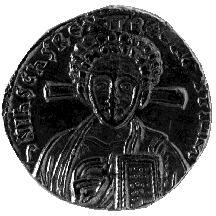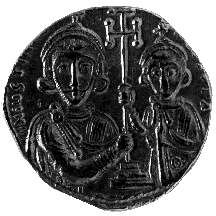



(139) Justinian II and Tiberius - AV solidus, A.D. 705-711, 4.27
g. (inv. 91.280).
Obverse: Facing bust of Christ with curly hair, cross behind head, r. raised
in blessing, l. holding Gospel book; D(OMINVS) N(OSTER) IhS(VS) Ch(RISTV)S
REX REGNANTIVM: Our Lord Jesus Christ, Ruler of those who rule.
Reverse: Facing half-figures of Justinian l. and Tiberius r., each wearing
crown and chlamys, holding between them cross potent on base; D(OMINI)
N(OSTRI) IVST[INIANVS ET TIBERIVS] P(ER)P(ETVI) A(VGVSTI): Our lords Justinian
and Tiberius, perpetual Augusti.
Provenance: Coin Galleries, 1959.
Bibliography: P. Grierson, Byzantine Coins (London 1982).
Justinian II, who first came to power in A.D. 685, was mutilated and ousted
by Leontius in A.D. 695 (see no. 138), but after ten years in exile "the
emperor without a nose," so nicknamed as a result of his mutilation,
returned to the throne for a second reign. In his first reign Justinian,
a devout Christian, had taken the important step of depicting Christ on
a coin for the first time and establishing the convention in which the image
of Christ on the obverse displaced the portrait of the emperor to the reverse
of the coin. In addition, the legend on the obverse proclaims that the emperor
is subject to Christ the King. The image of Christ was not used by the emperors
immediately following Justinian, but it was later revived, and its position
on the obverse determined the relationship between Christ and the emperor
on all later Byzantine coins.
In his second reign Justinian retained the image of Christ on the obverse,
but the type has changed from the stern, long-haired, fully bearded figure
of the Pantokrator common in Byzantine icons and mosaics to a youthful,
curly-haired Christ with a short beard, a type thought to be derived from
Syrian depictions of Christ.
For most of his second reign, Justinian ruled in association with his young
son, Tiberius, who is pictured with him on the reverse, his youth and junior
status indicated by his scale and position on the right. Together they hold
the cross potent on a stepped base, which formerly had been the standard
reverse type. Justinian was ruthless in exacting revenge upon his many enemies,
and in the end both he and his young son were murdered.
R.K.B.



All contents copyright (c) 1996.
Lawrence University
All rights reserved.